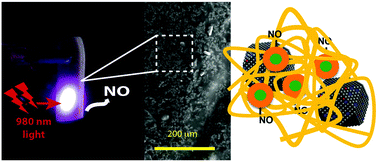Light-controlled release of nitric oxide from solid polymer composite materials using visible and near infra-red light†
Abstract
Photochemical Nitric oxide releasing composite materials (Photo-NORMs) were prepared using biocompatible polymers and the photochemical nitric oxide donor complex (CrONO). We have demonstrated nitric oxide (NO) release from the solid composites for extended (>30 hours) and controlled (20–100 pmoles s−1) durations after visible light irradiation. Quantitation of the efficiency of NO release from the composites shows that polymer gas permeability most dramatically affects the overall efficiency (QY) of photochemical NO release, where polymers with higher gas permeability have a higher QY of nitric oxide release. Composites were also prepared with β-phase lanthanide-doped NaYF4 upconverting nanoparticles (UCNPs). Controlled Nitric oxide release was achieved via near infrared (NIR) irradiation. A prototype LED device shows proof-of-concept that such photoresponsive NO-releasing composites could be applied to implantable systems, where the amount of NO released is modulated by changing irradiation time and light intensity. This research provides the guidelines necessary to move towards device fabrication and testing in actual tissue to evaluate the photo-NORMS as a reliable option for nitric oxide release in vivo.


 Please wait while we load your content...
Please wait while we load your content...